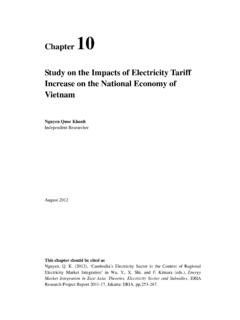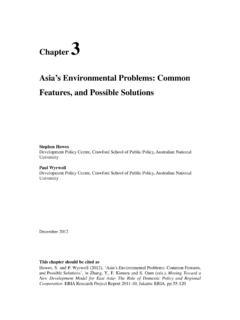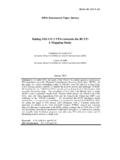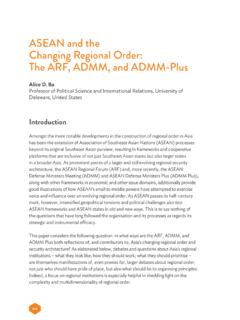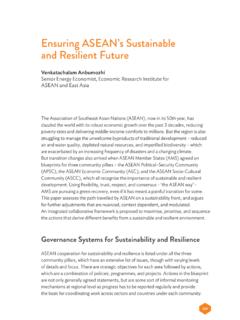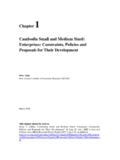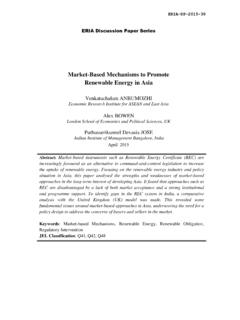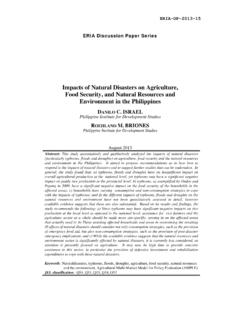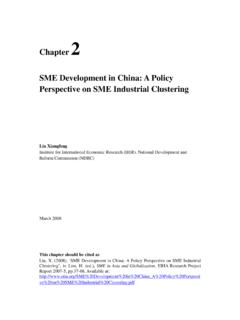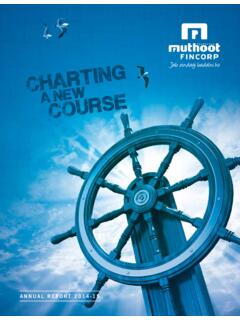Transcription of Lao PDR at the Crossroads: Industrial Development ...
1 Lao PDR at the crossroads : Industrial Development strategies 2016 2030 edited by Hidetoshi Nishimura Fukunari Kimura Masahito Ambashi Souknilanh Keola Economic Research Institute for ASEAN and East Asia, 2016 Published in June 2016 The findings, interpretations, and conclusions expressed herein do not necessarily reflect the views and policies of the Economic Research Institute for ASEAN and East Asia, its Governing Board, Academic Advisory Council, or the Institutions and governments they represent. All rights reserved. Material in this publication may be freely quoted or reprinted with proper acknowledgement.
2 National Library of Indonesia Cataloguing in Publication Data ERIA Research Project FY2015 ISBN: 978-602-8660-90-7 Cover Art by Artmosphere iii Foreword Lao PDR has achieved remarkable economic growth in recent years. With growing international division of labour, the country has gradually integrated with international global production networks based on the second unbundling. This economic achievement is exemplified by improved living standards throughout the country, as indicated by an increase in per capita income. On the other hand, Lao PDR faces the problems of an overdependence on the energy and mineral sectors, and growing Development gaps within the country.
3 Lao PDR is at a turning point, where it can turn its weakness of being a landlocked country into its strength, by becoming a land-linked country in the Mekong Region. As chair of the ASEAN Summit and the East Asia Summit this year a role it takes on only every 10 years Lao PDR has a great opportunity to announce its novel Industrial Development strategy to potential investors around the world. Lao PDR at the crossroads , the research title, refers to this crucial time for a decision about the country s future and its central location as a transport hub in the Mekong Region. These circumstances were motivation for the Lao PDR government and the Economic Research Institute for ASEAN and East Asia (ERIA) to create a unique mid- and long-term Development vision, titled Lao PDR at the crossroads : Industrial Development strategies 2016 2030.
4 The study was designed to generate concrete policy measures and recommendations that, if adopted, are likely to contribute to the further Development and growth of Lao PDR. I am strongly convinced that the analyses and policy recommendations presented in Lao PDR at the crossroads will be conducive to the pursuit of new Development strategies . Its ideas and policy recommendations were also incorporated into Lao PDR s official plans such as the 10-Year Development Strategy (2016 2025) and Vision 2030 (2016 2030). The policy measures proposed in this study are expected not only to promote the economic Development of Lao PDR, but also to improve connectivity in the ASEAN region as a whole.
5 I firmly believe that Lao PDR at the crossroads will contribute to the revision of the Master Plan on ASEAN Connectivity. iv Foreword First and foremost, I would like to express my special appreciation for the continuous support of the Ministry of Industry and Commerce (MOIC) under the auspices of Khemmani Pholsena, Minister for MOIC. I am deeply indebted to those directly involved in this project. Fukunari Kimura, ERIA s Chief Economist, Masahito Ambashi, ERIA Economist, and Souknilanh Keola, IDE JETRO Research Fellow, who edited the whole report and to achieve near-perfection. There were also substantial contributions from two Lao institutes and their researchers: the National Economic Research Institute (Leeber Leebouapao, Sthabandith Insisienmay, and Vanthana Nolintha) and the Economic Research Institute for Trade (Xaysomphet Norasingh, Viengsavang Thipphavong, Thantavanh Manolom, Lekxay Keoyasan, and Vanaxay Soukhaseum) who wrote the drafts of Chapters 2 to 4 and provided invaluable data.
6 Daiwa Institute of Research Ltd. (Masahiro Nakamura, Hideaki Kasai, Jin Yoshida, Keisuke Goto, Sanae Ota, Yu Karasawa, and Rei Naka) largely contributed Chapters 5 and 6 by conducting extensive field surveys. And the IDE JETRO Geographical Simulation Model team (Satoru Kumagai and Ikumo Isono) supported the quantitative analysis of Chapter 7 with their expertise. I would also like to thank other ERIA staff: Yasuhiro Yamada, for his enthusiastic support in Vientiane, and Jeremy Gross, for coordinating the National Policy Dialogue on 30 March 2016. I would also like to express my gratitude to Maria Priscila del Rosario, Stefan Wesiak, Fadriani Trianingsih, and Chrestella Budyanto for their editorial and publishing support.
7 I hope that Lao PDR at the crossroads will be a useful reference for the Lao PDR government as well as international donor agencies and funding institutions, to help them take concrete actions for promoting the Industrial Development of the country. Professor Hidetoshi Nishimura President, Economic Research Institute for ASEAN and East Asia June 2016 v Contents List of Abbreviations vi Executive Summary vii Introduction 1 Chapter 1 Medium and Long-Term Development strategies 5 Chapter 2 The Phasing of Development Paths 15 Chapter 3 Well-Coordinated Policies 23 Chapter 4 Immediate Issues 43 Chapter 5 The Development of Industrial Estates 61 Chapter 6 Industrial Studies 99 Chapter 7 Geographical Simulation Analysis 225 Conclusion and Recommendations 241 Appendix 247 vi List of Abbreviations and Acronyms ADB Asian Development Bank AEC Asian Economic Community
8 ASEAN Association of Southeast Asian Nations B Thai baht BCEL Banque pour le Commerce Exterieur Lao BOL Bank of the Lao PDR CLMV Cambodia, Lao PDR, Myanmar, and Viet Nam DIR Daiwa Institute of Research Ltd. E&E electrical and electronic components EPZ export processing zone ESB Eastern Seaboard Branch ERIA Economic Research Institute for ASEAN and East Asia ESB Eastern Seaboard EU European Union FAO Food and Agriculture Organization of the United Nations FDI foreign direct investment FTA free trade agreement GDP gross domestic product GOL Government of Lao PDR GRP gross regional product GSM ERIA/IDE Geographical Simulation Model HAI human asset index IEAT Industrial Estates Authority of Thailand IDE Institute of Developing Economies IE Industrial estate IMF International Monetary Fund IP
9 Industrial park JETRO Japan External Trade Organization JICA Japan International Cooperation Agency km kilometre KN Laotian kip LDC least developed country ODA official Development assistance SEZ Special Economic Zone SMEs small and medium-sized enterprises US United States US$ United States dollar WTO World Trade Organization vii Executive Summary Professor Hidetoshi Nishimura (President of ERIA) and the Study Team Lao PDR at the crossroads : Industrial Development strategies 2016 2030 is an outcome of the research initiated upon the request of Khemmani Pholsena, Minister for Industry and Commerce.
10 The Lao PDR government has been concerned that while economic growth has increased per capita income more than seven times from US$ to nearly US$1,800 since 1991, it now encounters two serious challenges. Firstly, the growth has been based on a few sectors that are dependent on exhaustible mineral resources. The mining and energy industries hardly generate sufficient employment required for inclusive growth. In other words, the economic Development of Lao PDR may not be necessarily robust. Secondly, Development gaps have widened between and within regions in the country. While the Lao PDR government attempts to formulate the 10-Year Development Strategy (2016 2025) and Vision 2030 (2016 2030) to address these two challenges, this study aims to provide potential inputs, from different perspectives, particularly to mid- and long-term comprehensive Industrial Development strategies .
